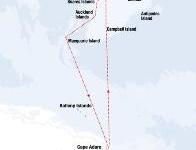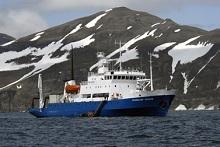Recently Viewed Cruises
- Enderby, In the Wake of Scott & Shackleton ex Bluff ReturnAdd to favourites
- MS Expedition, Spirit of Shackleton ex Ushuaia ReturnAdd to favourites
- Polar Pioneer, Sth Georgia & Antarctica 2013/14 ex Ushuaia to Port StanleyAdd to favourites
- Bremen, (INT) Antarctica ex Ushuaia ReturnAdd to favourites
- Orion, Mawsons Antarctica ex Dunedin ReturnAdd to favourites
- Royal Caribbean International raises the bar
- Classy Astor fills gap in market
- Oceanic Discoverer
- Ab Fab Oosterdam
- Catch up on Cruising: Latest cruise news in bite size
- Frequently Asked Questions
-
Enderby, In the Wake of Scott & Shackleton ex Bluff Return
Nights 28 Ship Spirit of Enderby Star Rating Specialty Departs Bluff, New Zealand Sailing 2014: 11 Jan ,8 Feb Ports of Call Bluff, Snares Island, Auckland Islands, Macquarie Island, Cape Adare, Cape Hallett, Ross Island, Campbell Island Please enquire about this cruise for pricing.
27 Night Cruise sailing from Bluff roundtrip aboard Spirit of Enderby. 1 night stay pre-cruise in Invercargill.
The ultimate Antarctic Voyage. Voyage to the very heart of Antarctica. The Ross Sea is one of the most remote regions and is only accessible for two months each year when the ice thaws. It is the historic gateway, discovered by Sir James Clark Ross in 1842, it was to the Ross Sea region that many of the most famous explorers and adventurers came. They included Borchgrevink, Scott, Shackleton, Amundsen, Richard Byrd, Sir Edmund Hillary and others.
There are 5 historic huts that we visit. These capture the history of these explorers and their achievements. The Ross Sea region is the breeding ground for millions of Adelie and Emperor penguins and we have regular encounters with both these species. New Zealand, America and Italy maintain scientific bases in the Ross Sea and welcome the few visitors that come each year. Our Ross Sea Expeditions include Subantarctic Auckland, Campbell and Macquarie Island where we have permits for landing.
Day 1: Invercargill
Arrive at Invercargill, New Zealand's southern most city and rich in Scottish history. Grab your last-minute luxuries before meeting your fellow expeditioners for an informal get-together over dinner.
Day 2: Depart Port of Bluff
Enjoy a visit to the museum to view the Subantarctic display before transferring to the Port of Bluff, where you will board the Spirit of Enderby. Settle into your cabin and join your Expedition Staff and the Captain for a welcome on board.
Day 3: Snares Islands
Staggeringly, the Snares Islands are home to more nesting seabirds than all of the British Isles put together. Zodiac cruising the coast we learn how the islands got their name and in the sheltered bays we should see the endemic Snares Crested Penguin, the Cape Petrel and Buller's Albatross nesting on the imposing cliffs.
Days 4 to 5: Auckland Islands
Characterised by towering cliffs and rugged sea stacks, these islands have borne witness to many a shipwreck in days gone by. We spend the day ashore on Enderby Island which is perhaps the most beautiful of all the Subantarctic Islands; here we find parakeets flitting above carpets of red, white and yellow wildflowers and, on the beaches beyond, the rare Hooker's or New Zealand Sea Lion. We land in Carnley Harbour and climb to a Shy Mollymawk colony and nests of the beautiful Wandering Albatross amongst the tussock.
Day 6: At Sea
Take the chance to learn more about the biology and history of the islands and the tempestuous Southern Ocean through informal lectures with our experts. Crossing the confluence of warmer and cooler waters at the Subantarctic Convergence we can expect to see a large number of pelagic species, including five or six kinds of albatross and petrel.
Days 7 to 8: Macquarie Island
This remote, rocky outpost in the middle of roaring westerly winds supports one of the highest concentrations of wildlife in the Southern Hemisphere. Expect a welcoming committee as a quarter of a million King Penguins stand to attention on shore. You will never forget your first experience in a ceaselessly active 'penguin city', where the dapper inhabitants show no fear of their strange visitors. We will also meet with the Park Rangers and observe the thousands of Elephant Seals along the beaches.
Days 9 to 12: At Sea
Soaring albatrosses and petrels circle the vessel as we steam south through the Southern Ocean. Lectures now concentrate on the Ross Sea region and, beyond the bows of the ship, drifting icebergs begin to appear in extraordinary shapes. Manoeuvring in close for your first ice photographs we pass the Antarctic Circle and into the continent's realm of 24-hour daylight.
Days 13 to 22: Antarctica's Ross Sea region
With unpredictable ice and weather conditions, a day-by-day itinerary is not possible but we assess the conditions daily and take every opportunity to make landings and launch the Zodiacs. You can anticipate wildlife viewing, visits to scientific bases and historic sites, as well as the spectacular white and blue scenery.
We hope to visit the following areas:
Cape Adare:
A large flat spit of land, teeming with the staggering sight of Antarctica's largest Adelie Penguin rookery: a tumult of chattering, feeding chicks; territorial disputes; petty pilfering and courtship displays. Curious penguins often come very close, offering superb photographic opportunities. Among the shifting mass of penguins we will find Carsten Borchgrevink's Hut, the oldest in Antarctica, an overwintering shelter for the first expedition to the Antarctic continent in 1899.
Cape Hallett:
The enormous Admiralty Range heralds our arrival; wild and extraordinary, the mountains rear up from the sea to over 4,000 metres, bounded by colossal glaciers. We land at an abandoned base site, now home to large numbers of Adelie Penguins and Weddell Seals.
Terra Nova Bay: An Italian research station where the scientists are always hospitable and enjoy showing us around their lonely but beautiful home. They share with us their scientific research and also, perhaps, the best 'cafe espresso' in Antarctica!
Franklin Island:
Desolately beautiful and rugged, this is home to a large Adelie Penguin population and other nesting seabirds. We attempt a landing and explore the coastline.
Ross Ice Shelf: The world's largest body of floating ice and a natural barrier, at times creating hazardous weather, with sheets of snow blown at gale force by winds off the polar ice cap. Just 800 miles from the South Pole, this daunting spectacle prevented many early explorers from venturing further south. We cruise along its dizzying 30 metre ice cliffs, perhaps lucky enough to see icebergs 'calving' from its carapace.
Ross Island:
Mt. Erebus/Cape Bird/Shackleton & Scott's Hut. Drop in at a scientific field station and visit the preserved huts of Sir Ernest Shackleton and Captain Robert Falcon Scott. Informal lectures explain many facets of these amazing early expeditions and towering behind Scott's hut broods Mt. Erebus, a monstrous active volcano named after the Ancient Greek God of Darkness.
Possession Islands: Rarely-visited, small and rugged, these rocks support tens of thousands of penguins. Observe the birds' busy and humorous activity, with the Admiralty Mountains forming a superb backdrop across the water.
Days 23 to 26: At Sea
Taking time to rest and enjoy shipboard life in the bar or library after the excitement and long daylight hours of the Antarctic, we have time for lectures on our final destination and for some pelagic bird spotting.
Day 27: Campbell Island
We drop anchor in Perseverance Harbour, an occasional refuge for Southern Right Whales who come here to calve. Walk to the nesting site of the Southern Royal Albatross and see the strange and beautiful 'mega herbs' growing on the hills, huge wildflowers that have adapted to the harsh conditions, with unusual colourings and weirdly-shaped leaves. We also seek out other wildlife such as Campbell Island Shags, Light-mantled Sooty Albatross and Sea Lions.
Day 28: At Sea
Relax and reflect on a remarkable journey, join our experts for a recap of highlights and enjoy a farewell dinner tonight.
Day 29: Port of Bluff, Invercargill
Finding final harbour once more in the Port of Bluff, we disembark and our adventure ends.







